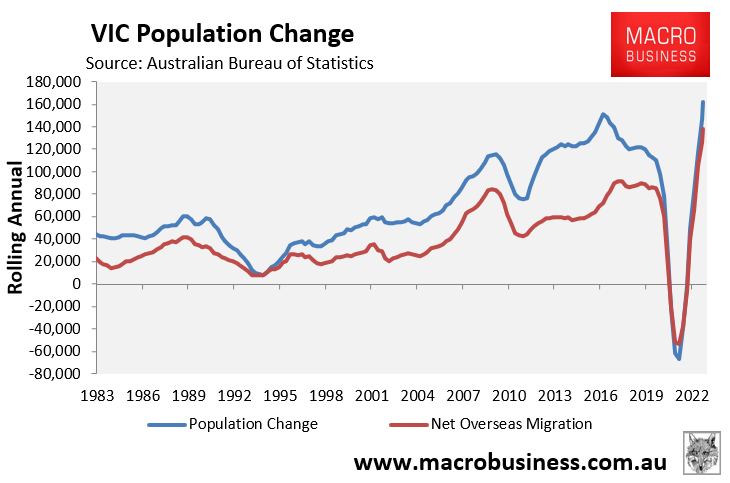Melbourne’s rapid population growth threatens to make the city unliveable.
The latest population data from the Australian Bureau of Statistics (ABS) showed that Victoria’s population grew by a record 161,700 in the year to March, driven by 137,600 net overseas migration (NOM):

This means Melbourne would have added around 130,000 over the year.
After increasing by more than half this century, the Federal Treasury’s Centre for Population forecast that Melbourne will have 6.1 million residents by 2033, with NOM accounting for approximately three-quarters of these new residents.
It would also imply that Melbourne’s population would nearly have doubled since the turn of the century, from about 3.3 million in 2001, owing primarily to high NOM.
Victorian Premier Dan Andrews told the Italian-language community newspaper Il Globo in July that he was urging the federal government to increase immigration even more:
“I’ve always been a very strong supporter of more skilled migration… but I think they might need to do more again”.
“Prime minister Albanese knows this. I’ve spoken to him about it personally and part of it also is clearing the Visa backlog”.
As Melbourne’s housing crisis worsens by the day amid the fastest population inflow in history, Dan Andrews outlined a proposal to squeeze an extra million dwellings into established suburbs by the middle of the century.
Andrews’ plan includes forcing development by denying local governments decision-making control over large developments.
The Andrews Government’s housing and planning revamp is expected to shield developers from legal disputes with councils and resident groups before the Victorian Civil and Administrative Tribunal (VCAT).
Speaking at the launch of a $210 million mixed-tenure housing project in inner-suburban Melbourne’s Kensington, Andrews said the government would speed up approvals processes.
Insiders in the industry are concerned that proposed state government housing changes could result in an increase in backdoor approvals for large developments, stripping people of their ability to object.
“This approval process bypasses local councils, communities and even Supreme Court decisions. Unfortunately we do not know how far this goes”, Former upper house MP Rod Barton.
“Essentially we are letting the minister sign off on development projects that do not meet planning regulations or zoning requirements or meet community interests. All due process has been forgotten”.
Dean Hurlston, vice president of Council Watch, expressed concern that the government will use the reforms to take planning powers from councils and local communities.
“Communities overwhelmingly want to have their say in overdevelopment”, he said.
“Locals must be included and heard”.
The Age has highlighted the impossibility of fitting one million more homes within the existing metropolitan footprint by 2050:
“Considering there are currently about 2.1 million dwellings in Greater Melbourne, hitting the target will require roughly one new dwelling for every two existing homes within the city’s boundaries”.
“Having taken about 188 years to get to our current situation, accommodating 50% more houses within existing boundaries in the next 20 years represents a major policy challenge”.
Premier Dan Andrews also appears to have forgotten what happened after the last decade’s high-rise construction boom:

Melbourne was inundated with large numbers of poor quality combustible apartments, which the state is still attempting to repair at great expense (see here and here).
What will happen if huge numbers of apartments are constructed quickly to meet Melbourne’s record-high levels of immigration-driven population growth?
Does Dan Andrews believe that building standards will remain stable, degrade, or improve?
The obvious conclusion is that construction quality will deteriorate even further in order to build apartments as quickly as possible to house the rapidly expanding population.
Infrastructure will also become increasingly congested, limiting Melburnians’ access to hospitals, schools, parks, and other public services. They will also be forced to spend more time stalled in traffic and on crowded public transport.
The obvious solution to Australia’s (particularly Melbourne’s) growing pains and diminishing liveability is to limit net overseas migration to levels proportionate to our ability to deliver new housing and infrastructure, as well as safeguarding the natural environment.
Nobody voted for record levels of immigration, and the vast majority of Australians are opposed to it.
Stop wrecking living standards by flooding our cities with people.

